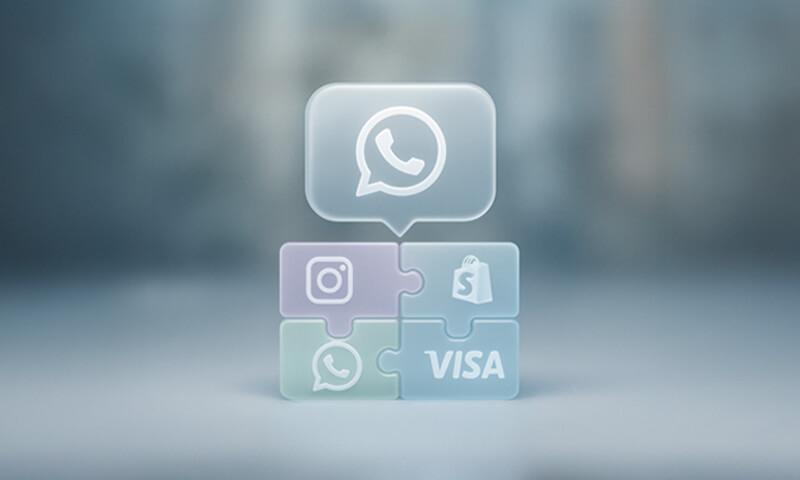Your Customers Already Told You How to Grow (But You Weren’t Listening)
A few years ago, I had an experience that changed my perspective on business. It didn’t happen in a boardroom. It happened with a customer who was complaining.
As I listened—really listened, not just waiting for my turn to defend MY product—I realized something: he wasn’t telling me about a problem. He was gifting me the solution.
That conversation taught me that the best opportunities hide where we’re not looking. In the complaints we dismiss. In the questions we answer on autopilot. In those chat messages we respond to quickly just to “close the ticket.”
Today, millions of companies have thousands of digital conversations every day. WhatsApp, web chat, social media, messaging apps. Selling, responding, solving.
But most aren’t truly listening.
I don’t mean reading and responding. I mean understanding. Analyzing. Discovering patterns. Finding hidden opportunities in every word a customer writes.
This is conversational commerce: turning conversations into knowledge, and knowledge into growth.
The New Language of Commerce
Imagine you have a business that serves customers. Before, if you wanted to know what they thought, you had few options: surveys nobody fills out, expensive studies, or guessing based on sales.
But now, every time a customer writes to you, they’re gifting you voluntary information. What they need, what confuses them, what excites them, what frustrates them. All recorded. Word by word.
Conversational commerce isn’t just “selling through chat.” It’s creating real dialogue where customers feel heard and you constantly learn.
Today, companies are at that moment. Traditional commerce—where you talk and the customer listens—no longer works. Customers want to converse. Be heard. They want personalized responses. They want to teach you.
Why does this matter NOW?
- First: Your customers already expect to talk to you. If you don’t offer that option, your competition will.
- Second: Technology finally caught up with our needs. Today you can handle hundreds of conversations with intelligent bots, analyze thousands of messages in minutes, and detect patterns that were previously invisible.
- Third: The data from these conversations is pure gold. It’s not forced survey responses. It’s data the customer gives naturally, in their own words, at the exact moment of interaction.
The crucial mindset shift is: stop thinking “how do I sell more through chat?” Start thinking “what can I learn from each conversation?”
When you change that belief, everything changes.
The Gold Mine You’re Ignoring
Every message is a story. Authentic. Without marketing filters. With layers. With context. With meaning beyond superficial words.
The problem: most people treat these messages as pending tasks. Respond and close. Next. Respond and close.
It’s like someone giving you winning lottery tickets and you using them to write your grocery list.
The five hidden treasures:
1. Repeated Questions
- If ten customers ask the same thing, it’s not coincidence. It’s a bright signal saying: “Something here isn’t clear.”
- Your website doesn’t explain something well. Your product is confusing. Your process has a step nobody understands.
- Every repeated question is a problem waiting to be solved. Solve it and you don’t just help those ten—you help the next hundred who won’t
need to ask.
2. The Exact Words
You sell “enterprise process optimization solutions.” Your customers are looking for “something to save me time in the daily chaos.”
See the difference?
When you analyze conversations, you discover your customers’ real language. Not te one you think they use. And when you use it in your marketing, magic happens: people feel you understand them.
Because you’re literally speaking their language.
3. The Emotions Behind the Text
- “This product saved my day.”
- “I don’t understand how this works.”
- “I feel frustrated.”
- “Exactly what I needed!”
Emotions are the GPS that tells you where you shine and where you fail.
You don’t need sophisticated technology to start. Just read carefully. Ask yourself: how does this person feel? What emotion lies beneath?
4. Hidden Sales Opportunities
- “Does this phone come with headphones?”
- “I wish it also had a case.”
- “I love it, but I wish it had…”
These aren’t just questions. They’re opportunities.
The customer asking about headphones will probably buy them if you offer them now. The one mentioning a case is literally asking you to sell them more.
5. Free Product Ideas
- “Why don’t you have express shipping?”
- “It would be great from my phone.”
- “All my friends ask where I got this.”
Insights you’d normally pay thousands to a consultant for. And your customers give them to you free. Voluntarily. In real time.
When your customers write with problems, complaints, questions—they’re not being difficult. They’re handing you the map to your next innovation.
Are you seeing the map? Or just extra work?
The Power Is in the Details
Three real stories (composites of things I’ve seen happen):
The Coffee Shop That Discovered a New Business
They implement chat in their app. Three months later, the owner reviews complete conversations. He notices something: every afternoon, 3–4 PM, twenty people ask “do you have anything to eat that’s not sweet? I need energy but not sugar.”
Twenty people. Every day. Same problem.
Professionals from the neighboring office building needed an afternoon snack. The coffee shop only offered sweet pastries. People didn’t buy anything and left.
Two weeks later: healthy snack line. Sales for that time slot double.
Cost of discovery: zero. Just reading what was already there.
The Hotel That Fixed Its Process
A manager downloads all the month’s conversations. Five hundred. Reads them all.
He discovers: 30% of people who start a reservation ask “Can I modify it later?” or “What if I need to cancel?”
A third of potential customers worried about flexibility.
He reviews the website. The cancellation policy is hidden in a PDF. Nobody sees it. Customers ask through chat. Some, not getting an immediate response, abandon out of uncertainty.
Solution: put the policy clear and visible in the first step. “Cancel at no cost up to 48 hours before.”
Completed reservations go up 15%. Queries about cancellations drop to almost zero.
The Online Store That Found Its Ideal Customer
Pet products. Doing well, nothing extraordinary.
The founder reviews chats and notices: there’s a type of customer who always buys more. Much more. And they always ask the same questions.
- “Is this safe for senior dogs?”
- “My dog has arthritis, will this help?”
- “Looking for something for a 12-year-old golden retriever with hip problems.”
Owners of old dogs. Desperate to help their pets.
She creates a new category: “Senior Dog Care.” Groups existing products, writes guides, uses these customers’ exact language.
In six months: 40% of total sales. Her unique positioning. Her ideal customer.
Everything was in the conversations she already had.
What do these success stories have in common?
None hired expensive consultants. None did focus groups. They just paid attention.
Numbers tell you what’s happening. Conversations tell you why.
The Responsibility That Comes with Power
Pause. I know you’re excited but now I need to talk to you about something serious.
All this power comes with enormous responsibility. Not optional. Fundamental.
I’ve seen brilliant companies ruin their reputation through poor data management. Well-intentioned entrepreneurs mess up by not thinking about ethical implications.
If you’re going to do this, do it with complete integrity.
Five non-negotiable principles:
1. Anonymity
- When you analyze, protect identity. You don’t need “John Perez asked about X”—you need “35 people asked about X.”
- Patterns don’t need names.
2. Security
- Those conversations are intimate. Private. Confidential.
- Encrypt everything. Limit access. Use secure platforms. Don’t leave conversations in open sheets anyone can see.
- A hack isn’t just a technical problem. It’s a betrayal of trust. And lost trust almost never returns.
3. Collect Only What’s Necessary
- Just because you can save everything doesn’t mean you should.
- Do I really need this information to serve better? Or do I just want it “just in case”?
- Less data stored = less risk.
4. Transparency
- Tell customers what you do with their conversations.
- Simple: “This conversation may be analyzed anonymously to improve our service.”
- Transparency generates trust. Secrecy generates suspicion.
- If your customer wouldn’t be comfortable with what you do with their information, you shouldn’t be doing it. Period.
5. Use for Good
- Use insights to improve product, make customers’ lives easier, solve problems faster, create better experiences.
- NOT to emotionally manipulate, take advantage of vulnerabilities, or pressure aggressive sales.
Technology is like a hammer. It builds houses or breaks windows. The difference is in the intention.
I’ve seen companies use data to exploit fears. Others to identify customers in trouble and help them proactively, even without making the sale.
Guess which ones keep growing with loyal customers.
This choice doesn’t just define your business. It defines who you are.
From Theory to Action
Okay. You understand the why. You’ve seen examples. You know the ethical principles.
Now: how do I do this?
It sounds intimidating. Data analysis, AI, dashboards, metrics… like you need a PhD and a Fortune 500 budget.
But no.
You need curiosity, discipline, and a simple system.
STEP 1: CAPTURE
• Record conversations in an organized system.
If you’re starting: use what you have. Reach and WhatsApp Business save conversations. Facebook Messenger too. Web chat platforms (Intercom, Drift, Tidio) have free basic versions.
You don’t need complex systems. You do need to be able to search and review conversations later.
STEP 2: ORGANIZE
- • Once a week, 2–3 hours, review conversations.
- Create simple categories:
- Product Questions
- Technical Problems
- Suggestions
- Complaints
- Praise
Keep a simple document:
STEP 3: ANALYZE
After 4 weeks, you have 4 documents. Look for big patterns.
Ask yourself:
- What question appeared all 4 weeks? (Urgent to fix)
- What language do they consistently use? (Should be in your marketing)
- Recurring negative emotion? (Damaging your brand)
- What opportunities did multiple customers mention? (Your next innovation)
You don’t need statistical software. You need to read, think, connect dots.
STEP 4: ACT
What separates the exercise from transformation.
Each month: choose THE THREE most important insights. Only three. Create an action plan for each.
Example:
Insight: “20 customers asked about same-day shipping.”
Action:
- This week: Make “Ships in 24–48 hours” visible
- This month: Research same-day express shipping costs
- Next quarter: If viable, implement
One insight. Concrete actions. Not “it would be good to do something.”
Golden rule: Better three changes based on real data than ten based on hunches.
Uncomfortable truth: most of you won’t do this.
Not because it’s difficult. Because it requires consistency. Discipline. Time spent each week without seeing instant results.
But those who do will have a brutal advantage.
They won’t guess what their customers want. They’ll know. With certainty. With evidence. With data based on exact words.
In a world where everyone’s shouting to be heard, businesses that truly listen win.
The Future Is Already Here
Ten years ago: without a website, disadvantage. Five years ago: without social media, out of the game.
Today: without analyzing conversations, you’re blind while everyone else can see.
And you’re still in time. This practice is just beginning. Most—even big companies—don’t do it well.
Imagine two companies. Same industry. Similar products. Similar prices.
- Company A: Launches products based on CEO’s hunch. Marketing with agency language. Responds to chats to close tickets. When something fails, guesses why.
- Company B: Launches products based on what 500 conversations revealed customers need. Marketing using customers’ exact words. Analyzes each chat to improve. When something fails, knows exactly why.
Which would you rather compete with? Which will exist in 5 years?
The future isn’t for the biggest. It’s for the most attentive. Those who listen better. Learn faster. Adapt with agility.
It all starts with something simple: paying attention to what customers are already saying.
The competitive advantage of the future won’t be technology. Technology will be available to everyone. It will be digital empathy. The ability to deeply understand customers in each interaction.
Knowing not just what they buy, but why. Not just what problems they have, but how they describe them. Not just what they need, but what they feel.
Companies that master this won’t just sell more. They’ll build communities. Create true loyalty. Generate organic recommendations.
Because we all want to be heard. Understood. Feel important.
When your company does that—listens and acts—you’re not just another business. You’re an ally. Someone who understands.
And that, in a noisy world, is impossible to replicate.







